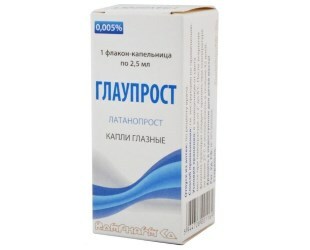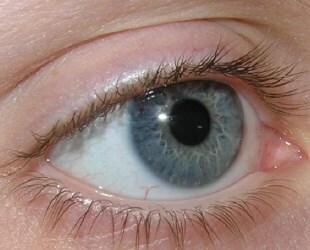
Glauprost( the main active substance is latanaprost) is a drug from the Romanian company called "Rompharm", which is mainly used for the treatment of glaucoma.
Excipients: sodium chloride, disodium hydrogen phosphate dodecahydrate, benzalkonium chloride, sodium dihydrogen phosphate dihydrate, purified water.
Pharmacological action
Glauprost is an antiglaucoma drug. This is an analogue of prostaglandin F2α and a selective agonist of FP-receptors.
- 1. Pharmacological action of
- 2. Pharmacokinetics
- 3. Indications
- 4. Dosage and administration of
- 5. Contraindications
- 6. Application of the drug during pregnancy
- 7. Side effects of
- 8. Drug interaction
- 9.Precautions and special instructions
- 10. Storage conditions
- 11. Shelf life
- 12. Average cost in Russia and Ukraine
- 13. Analogues
- 14. Patient feedback
Is able to reduce intraocular pressure by increasing the outflow of namesof aqueous humor, primarily on uveoscleral path or through the trabecular meshwork. It has absolutely no effect on the production of this watery moisture, and also does not affect the hemato-ophthalmic barrier in any way.
Gradual decrease in intraocular pressure occurs within 3-4 hours after the drug administration, the maximum effect reaches 8-12 hours, duration of action is not less than 24 hours.
Pharmacokinetics
- Distribution of the preparation .Gradually penetrates through the cornea, resulting in hydrolysis up to the biologically active form. The period of maximum effect in aqueous humor is 2 hours immediately after topical application.
- Removal of the preparation .In eye tissues the acid of the drug Latanoprost is almost not metabolized;mainly the metabolism occurs in the liver.
T1 / 2 - only 17 minutes. The main metabolites are 1,2-dinor-, and 1,2,3,4-tetranor metabolites have little or no biological activity at all. The drug is excreted exclusively by the kidneys.
Indications
The drug is indicated for use only in the following cases:
- With open-angle glaucoma.
- With increasing intraocular pressure.
Method of administration and dose

The drug is prescribed only locally in the conjunctival sac of the diseased eye once a day, one drop at night;In case of missed dose, the next reception should be entered as usual.
The drug is prescribed mainly to patients with:
- increased intraocular pressure;
- open-angle glaucoma.
The drug Glauprost must necessarily be prescribed by an ophthalmologist. Without prior consultation with a specialist, self-use is not recommended.
Contraindications
Do not use drops:
- people with increased sensitivity to any component components;
- for teenagers under 18 years of age.
Caution should be applied to these drops of pregnant women - in all cases, appoint only a doctor and only if the effect of their use will be much higher than the harm to the development of the fetus.
This remedy should be used with caution in patients suffering from:
- aphakia,
- with inflammatory glaucoma,
- with macular edema,
- pseudofakia, which is caused by complications of damage to the posterior part of the lens.
Usage of the drug during pregnancy
During pregnancy, use the drug with caution, but only when the benefit to the mother significantly exceeds the risk to the fetus.
Studies of the effect of the latanoprost preparation on reproduction have already been carried out on rabbits and rats. Four of the sixteen female rabbits, who received a dose of latanoprost, 80 times higher than the MPD, did not have viable fruits in the uterus.
The highest dose, which does not have embryocidal effect in rabbits, was as a result of 15 MPD.In pregnant women, such controlled, adequate studies were not conducted.
There is still no data on the penetration of latanoprost drug or its metabolites into breast milk. Since many drugs are excreted in breast milk, it is necessary to use with caution the drug latanoprost to nursing women.
Side effects of

Vision organs. Eye irritation( itching, burning sensation, foreign body tingling sensation, sensation of sand in the eyes), eye pain, blepharitis, eyelid edema, conjunctival hyperemia, corneal edema and erosion, eye pain, increased number, lengthening and thickening of eyelashes, andalso pulmonary hair, increased iris pigmentation, conjunctivitis, transient point erosions of the epithelium, iritis / uveitis, changes in the direction of eyelash growth, keratitis, blurred vision, macular edema( cystoid), sometimes causing eye irritation.
Possible systemic side effects. Four percent of all patients had colds, flu, upper respiratory tract infections, and 1-2% had muscle, chest, angina pain, joint pain, back pain, and rash and allergic skin reactions.
In the postmarketing observations, when using the drug,
- was observed: erosion and corneal edema,
- bronchial asthma or exacerbation of bronchial asthma,
- dyspnea,
- changes in hair and eyelashes( increase in thickness, length, number and pigmentation),
- severe darkening of the skin of the eyelids,
- herpetic keratitis,
- intraocular inflammation( iritis, uveitis),
- keratitis,
- macular edema,
- dysplasia of the eyelash growth,
- leading to eye irritation, toxic epidermalekroliz.
All of these side effects messages came exclusively from a population of only unknown volume voluntarily, which means that they were not properly controlled and most likely related both to the use of Latanoprost and to other factors, therefore one can not accurately assess their frequency and significance.
Drug Interaction
There is evidence of a possible paradoxical rise in IOP in the case of joint intake of several drugs of this group. Therefore, specialists do not recommend the simultaneous administration of several drugs that relate to prostaglandins, as well as derivatives or their analogues.
Clinical studies have shown the effectiveness of the combined use of Glaeoprost with Timolol. Despite this, there are some data on the mutual potentiation of the action of Glauprost in combination with various adrenomimetics( epinephrine), cholinomimetics( pilocarpine) or oral inhibitors of carbanhydrase( acetazolamide).
Ophthalmic preparations for the NSAID group( bromfenac, diclofenac, flurbiprofen, ketorolac, napafenac), reduce the concentration or may reduce the therapeutic effect of latanoprost.
Precautions and special instructions

It is forbidden to use latanoprost more than once a day, because frequent administration can reduce the therapeutic effect.
The patient should be warned that if unwanted eye reactions develop, seek immediate help. The use of multi-dose vials of this drug is quite dangerous for the possible development of various eye infections.
Before the beginning of therapy, it is necessary to inform the patient about the risk of eye color changes( especially if the treatment is prescribed only one eye, because the color change of the eyes is irreversible), the color changes, the length, the number and thickness of the eyelashes, the direction of their growth, and also the darkeningcontiguous eyelid skin. In the case of increased pigmentation, it is allowed to stop therapy.
This drug can be used during pregnancy, but only if the potential benefit to the mother is significantly higher than the potential risk to the fetus.
There is no reliable data on the penetration of the drug into breast milk. Therefore, it is allowed to use the drug Glauprost during breastfeeding.
Before starting instillation of Glauprost necessarily remove contact lenses due to the adsorption of chloride benzalkonium, which is contained in the preparation. After instillation, the lens can be worn after 15 minutes.
Patients, with possible blurring of vision due to the use of Eye Drops Glauprost, experts do not recommend driving vehicles or work with mechanisms until it is completely restored.
Storage conditions
As with any medicine, in a dark place at a temperature of 2-8 ° C.The open bottle is allowed to be stored for no more than four weeks in a cold and sheltered place from the light and children.
Shelf Life
For use within 3 years. But the open vial is allowed to be stored for no more than four weeks.
Average cost in Russia and Ukraine
The average cost of the drug Glauprost in Russia is 300 rubles, and in Ukraine - 80 hryvnia.
Analogues of
The most effective analogues of the drug Glauprost are the following medicines:
- Xalatan - the average cost in Russia is 720 rubles.
- Travatan - 600 rubles.
- Betoptik - 240 rubles.
- Timolol - 65 rubles.
- Pilocarpine - 120 rubles.
- Kosopt - 580 rubles.
- Azopt - 580 rubles.
- Fotil - 230 rubles.
- Trusopt - 540 rubles.
- Okumed - 65 rubles.
- Azarga - 720 rubles.
Patient Reviews
Use of Glaaprost because of the increase in the total amount of brown pigment in the iris can cause a gradual change in eye color. This effect is most often detected in patients with mixed colors of the iris, for example, blue-brown, yellow-brown, gray-brown or green-brown, this is explained by the increase in the amount of melanin in melanocytes of the iris.
Most often, this brown pigmentation concentrates around the pupil and toward the periphery of the iris of the eyes, the entire iris or parts of it can acquire the most intense brown color. With intensive changes in eye pigmentation, therapy should be discontinued.
The preparation Glauprost is the most optimal variant, it is not expensive and at the same time it is quite effective.
Its low cost is due to the small content of various components. But even so, this drug is very much praised.
According to many patients, the drug Glauprost is the best drug for rapid pain relief. Even with such diseases as acute angular glaucoma, this drug helps effectively and immediately. Reviews of people who used this drug are mostly positive, you can read more about them at the end of this article.
